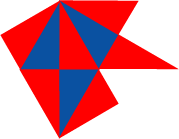Let $P$ be a convex $n$-gon. Suppose that we have an infinite number of $P$s, and that each of them is colored either red or blue. Here, let us consider the following operations :
Operation 1 : Place a red $P$ on a plane.
$\ \ \ \ \ \ \ \ \ \ \ \ \ \ \ \ \ \ \ \ \ \ \ \ \ $
Operation 2 : Place $n$ blue $P$s around the red $P$ such that each of the blue $P$s and the red $P$ are laid symmetrically with each $E_i\ (i=1,2,\cdots,n)$ where $E_i$ is an edge of the red $P$.
$\ \ \ \ \ \ \ \ \ \ \ \ \ \ \ \ \ \ \ \ \ \ \ \ \ $
Operation 3 : Place $n$ red $P$s around every blue $P$ in the same way as operation 2.
$\ \ \ \ \ \ \ \ \ \ \ \ \ \ \ \ \ \ \ \ \ \ \ \ \ $
Operation 4 : Place $n$ blue $P$s around every red $P$ in the same way as operation 2.
Operation 5 : Repeat operation 3 and 4.
Here, let us consider the following conditions :
Condition 1 : These $P$s are plane tessellation figures.
Condition 2 : There exists no place where both red $P$ and blue $P$ are placed.
Note that a regular hexagon, for example, does not satisfy the condition 2. See the figure below. The blue $P$ on which a letter $P$ is written, for example, will be colored red by the next operation.
$\ \ \ \ \ \ \ \ \ \ \ \ \ \ \ \ \ \ \ \ \ \ \ \ \ $
Then, here is the first question.
Question 1 : Is the following true?
$P$ satisfies these two conditions $\iff$ $P$ is either "a $45–45–90$ triangle", "a $30–60–90$ triangle", "an equilateral triangle" or "a rectangle".
I reached this conjecture by considering the inner angles of $P$. The followings are what I've thought : Every inner angle, say $\alpha$, of $P$ has to satisfy $2m\alpha=360^{\circ}$ where $m\ge 2\in\mathbb N$. Hence, $\alpha$ has to be any of the positive divisors of $180$ except $180$. This leads $n\le 4$ and so on.
Then, here is the second question.
Question 2 : Letting $P$ be a convex polyhedron, how about the three dimensional version of this question? Suppose that we consider the plane symmetry instead of the line symmetry.
In the two dimensional version, I think we can consider the inner angles of $P$. However, I don't have any good idea for the higher dimensional version. Can anyone help?
